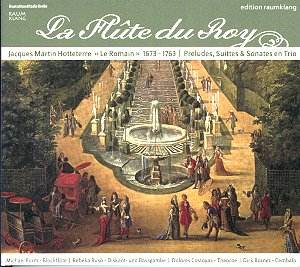Jacques Martin Hotteterre
was a member of a large family, which
had its roots in Normandy. Since the
early 17th century most of the Hotteterres
had devoted themselves to instrument-making.
Some of them moved to Paris and from
that vantage point had a strong influence
on the technical development of wind
instruments. They played a crucial role
in the transformation of renaissance
instruments into their baroque counterparts.
Most of the Hotteterres also played
instruments: at least six of them played
under Lully's direction in the 1670s.
Jacques Martin was
also active as a player: he received
an important position at the royal court,
granting him a high social status. Instead
of making wind instruments, he concentrated
on composition and on teaching the transverse
flute. As a composer he was one of the
first to write sonatas and suites for
the instrument. One of the most important
aspects of Hotteterre's playing and
composing was the ornamentation. This
is borne out by reports of his own performances
as well as by the second edition of
his 1er Livre. There is also a strong
Italian element in his oeuvre, which
is particularly demonstrated by the
trio sonatas opus 3. The catalogue of
his private library gives further evidence
of his interest in Italian music. This
could be the reason he was nicknamed
'the Roman'.
It may be a surprise
that the music of a composer who has
devoted most of his time to playing
the transverse flute is performed here
on the recorder, an instrument whose
popularity was waning after 1700. However
there is ample justification for this.
First, most composers were rather flexible
in regard to the choice of instruments
in the performance of their compositions.
The title pages often refer to several
instruments, like the 2e Livre by Hotteterre:
'Deuxième Livre de Pièces
pour la Flûte-Traversière
et autres Instruments avec la Basse'
(pieces for the transverse flute and
other instruments with basso continuo).
And on the title page of the trio sonatas
opus 3 the recorder is specifically
mentioned: 'Sonates en Trio pour les
Flûtes Traversière, Flûtes
à Bec, Violons, Hautbois etc'.
Secondly, in his treatise 'Principes
de la Flûte traversière'
he devotes several pages to the recorder.
He recommends transposition upwards
if his music is to be played on the
treble recorder. In this recording a
voice flute is used; as this instrument
is pitched a minor third lower than
the treble recorder, all pieces on the
programme are played in the original
keys.
This disc is not the
first devoted to Hotteterre's music,
but in my opinion it is definitely the
most interesting as far as performance
practice is concerned. In his liner
notes Michael Form underlines the emotional
and expressive element of French music.
Although a public display of human emotions
was felt to be unacceptable in those
days, the use of dissonances and rhetorical
motifs to create a plaintive mood, for
instance, shows that this music is more
than just about pleasing the ear.
The expressive character
is also demonstrated by the contrasts
in tempo. For this recording Michael
Form has looked into period publications
which describe the original tempi in
which dances at that time were played.
"In his Elements ou principes de
musique (1696), Etienne Loulié
demonstrated how a pendulum can be used
to determine and record musical tempi
... with far greater precision than
with a modern metronome! It is astonishing
how little tempo instructions for many
dance movements varied over several
generations". In particular the menuet
turns out to be a dance which was played
at a very fast tempo. It is only in
the second half of the 18th century
that the menuet begins to slow down.
Another aspect of Hotteterre's playing
- as mentioned above - is the extensive
ornamentation, which has also been paid
attention to in this recording.
The result is a very
exciting performance, which reveals
aspects of French baroque music, which
too often remain underexposed. This
approach is not entirely new, though.
For example, Jed Wentz, with his ensemble
Musica ad Rhenum, has paid attention
to period writings about tempo. Listen,
for instance, to their complete recording
of François Couperin's chamber
music. It is however encouraging when
musicians do not just follow established
practices, but show a willingness to
study the sources themselves and take
the consequences.
Johan van Veen







